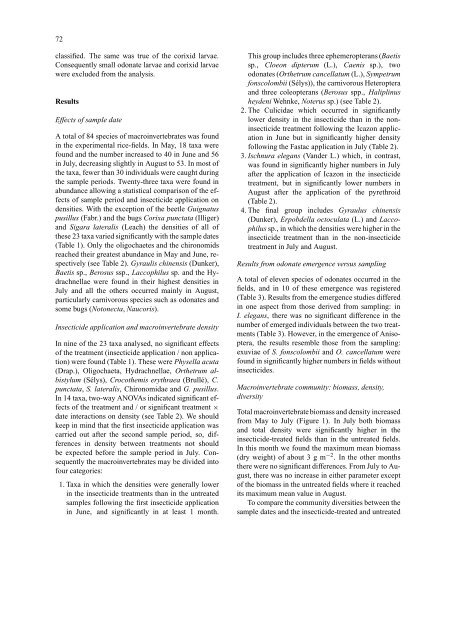Suhling et al. - 2000 - Effects of insecticide applications on macroinvert
Suhling et al. - 2000 - Effects of insecticide applications on macroinvert
Suhling et al. - 2000 - Effects of insecticide applications on macroinvert
Create successful ePaper yourself
Turn your PDF publications into a flip-book with our unique Google optimized e-Paper software.
72<br />
classified. The same was true <str<strong>on</strong>g>of</str<strong>on</strong>g> the corixid larvae.<br />
C<strong>on</strong>sequently sm<str<strong>on</strong>g>al</str<strong>on</strong>g>l od<strong>on</strong>ate larvae and corixid larvae<br />
were excluded from the an<str<strong>on</strong>g>al</str<strong>on</strong>g>ysis.<br />
Results<br />
<str<strong>on</strong>g>Effects</str<strong>on</strong>g> <str<strong>on</strong>g>of</str<strong>on</strong>g> sample date<br />
A tot<str<strong>on</strong>g>al</str<strong>on</strong>g> <str<strong>on</strong>g>of</str<strong>on</strong>g> 84 species <str<strong>on</strong>g>of</str<strong>on</strong>g> <strong>macroinvert</strong>ebrates was found<br />
in the experiment<str<strong>on</strong>g>al</str<strong>on</strong>g> rice-fields. In May, 18 taxa were<br />
found and the number increased to 40 in June and 56<br />
in July, decreasing slightly in August to 53. In most <str<strong>on</strong>g>of</str<strong>on</strong>g><br />
the taxa, fewer than 30 individu<str<strong>on</strong>g>al</str<strong>on</strong>g>s were caught during<br />
the sample periods. Twenty-three taxa were found in<br />
abundance <str<strong>on</strong>g>al</str<strong>on</strong>g>lowing a statistic<str<strong>on</strong>g>al</str<strong>on</strong>g> comparis<strong>on</strong> <str<strong>on</strong>g>of</str<strong>on</strong>g> the effects<br />
<str<strong>on</strong>g>of</str<strong>on</strong>g> sample period and <str<strong>on</strong>g>insecticide</str<strong>on</strong>g> applicati<strong>on</strong> <strong>on</strong><br />
densities. With the excepti<strong>on</strong> <str<strong>on</strong>g>of</str<strong>on</strong>g> the be<str<strong>on</strong>g>et</str<strong>on</strong>g>le Guignatus<br />
pusillus (Fabr.) and the bugs Corixa punctata (Illiger)<br />
and Sigara later<str<strong>on</strong>g>al</str<strong>on</strong>g>is (Leach) the densities <str<strong>on</strong>g>of</str<strong>on</strong>g> <str<strong>on</strong>g>al</str<strong>on</strong>g>l <str<strong>on</strong>g>of</str<strong>on</strong>g><br />
these 23 taxa varied significantly with the sample dates<br />
(Table 1). Only the oligocha<str<strong>on</strong>g>et</str<strong>on</strong>g>es and the chir<strong>on</strong>omids<br />
reached their greatest abundance in May and June, respectively<br />
(see Table 2). Gyraulis chinensis (Dunker),<br />
Ba<str<strong>on</strong>g>et</str<strong>on</strong>g>is sp., Berosus ssp., Laccophilus sp. and the Hydrachnellae<br />
were found in their highest densities in<br />
July and <str<strong>on</strong>g>al</str<strong>on</strong>g>l the others occurred mainly in August,<br />
particularly carnivorous species such as od<strong>on</strong>ates and<br />
some bugs (Not<strong>on</strong>ecta, Naucoris).<br />
Insecticide applicati<strong>on</strong> and <strong>macroinvert</strong>ebrate density<br />
In nine <str<strong>on</strong>g>of</str<strong>on</strong>g> the 23 taxa an<str<strong>on</strong>g>al</str<strong>on</strong>g>ysed, no significant effects<br />
<str<strong>on</strong>g>of</str<strong>on</strong>g> the treatment (<str<strong>on</strong>g>insecticide</str<strong>on</strong>g> applicati<strong>on</strong> / n<strong>on</strong> applicati<strong>on</strong>)<br />
were found (Table 1). These were Physella acuta<br />
(Drap.), Oligocha<str<strong>on</strong>g>et</str<strong>on</strong>g>a, Hydrachnellae, Orth<str<strong>on</strong>g>et</str<strong>on</strong>g>rum <str<strong>on</strong>g>al</str<strong>on</strong>g>bistylum<br />
(Sélys), Crocothemis erythraea (Brullé), C.<br />
punctata, S. later<str<strong>on</strong>g>al</str<strong>on</strong>g>is, Chir<strong>on</strong>omidae and G. pusillus.<br />
In 14 taxa, two-way ANOVAs indicated significant effects<br />
<str<strong>on</strong>g>of</str<strong>on</strong>g> the treatment and / or significant treatment ×<br />
date interacti<strong>on</strong>s <strong>on</strong> density (see Table 2). We should<br />
keep in mind that the first <str<strong>on</strong>g>insecticide</str<strong>on</strong>g> applicati<strong>on</strong> was<br />
carried out after the sec<strong>on</strong>d sample period, so, differences<br />
in density b<str<strong>on</strong>g>et</str<strong>on</strong>g>ween treatments not should<br />
be expected before the sample period in July. C<strong>on</strong>sequently<br />
the <strong>macroinvert</strong>ebrates may be divided into<br />
four categories:<br />
1. Taxa in which the densities were gener<str<strong>on</strong>g>al</str<strong>on</strong>g>ly lower<br />
in the <str<strong>on</strong>g>insecticide</str<strong>on</strong>g> treatments than in the untreated<br />
samples following the first <str<strong>on</strong>g>insecticide</str<strong>on</strong>g> applicati<strong>on</strong><br />
in June, and significantly in at least 1 m<strong>on</strong>th.<br />
This group includes three ephemeropterans (Ba<str<strong>on</strong>g>et</str<strong>on</strong>g>is<br />
sp., Cloe<strong>on</strong> dipterum (L.), Caenis sp.), two<br />
od<strong>on</strong>ates (Orth<str<strong>on</strong>g>et</str<strong>on</strong>g>rum cancellatum (L.), Symp<str<strong>on</strong>g>et</str<strong>on</strong>g>rum<br />
f<strong>on</strong>scolombii (Sélys)), the carnivorous H<str<strong>on</strong>g>et</str<strong>on</strong>g>eroptera<br />
and three coleopterans (Berosus spp., H<str<strong>on</strong>g>al</str<strong>on</strong>g>iplinus<br />
heydeni Wehnke, Noterus sp.) (see Table 2).<br />
2. The Culicidae which occurred in significantly<br />
lower density in the <str<strong>on</strong>g>insecticide</str<strong>on</strong>g> than in the n<strong>on</strong><str<strong>on</strong>g>insecticide</str<strong>on</strong>g><br />
treatment following the Icaz<strong>on</strong> applicati<strong>on</strong><br />
in June but in significantly higher density<br />
following the Fastac applicati<strong>on</strong> in July (Table 2).<br />
3. Ischnura elegans (Vander L.) which, in c<strong>on</strong>trast,<br />
was found in significantly higher numbers in July<br />
after the applicati<strong>on</strong> <str<strong>on</strong>g>of</str<strong>on</strong>g> Icaz<strong>on</strong> in the <str<strong>on</strong>g>insecticide</str<strong>on</strong>g><br />
treatment, but in significantly lower numbers in<br />
August after the applicati<strong>on</strong> <str<strong>on</strong>g>of</str<strong>on</strong>g> the pyr<str<strong>on</strong>g>et</str<strong>on</strong>g>hroid<br />
(Table 2).<br />
4. The fin<str<strong>on</strong>g>al</str<strong>on</strong>g> group includes Gyraulus chinensis<br />
(Dunker), Erpobdella octoculata (L.) and Laccophilus<br />
sp., in which the densities were higher in the<br />
<str<strong>on</strong>g>insecticide</str<strong>on</strong>g> treatment than in the n<strong>on</strong>-<str<strong>on</strong>g>insecticide</str<strong>on</strong>g><br />
treatment in July and August.<br />
Results from od<strong>on</strong>ate emergence versus sampling<br />
A tot<str<strong>on</strong>g>al</str<strong>on</strong>g> <str<strong>on</strong>g>of</str<strong>on</strong>g> eleven species <str<strong>on</strong>g>of</str<strong>on</strong>g> od<strong>on</strong>ates occurred in the<br />
fields, and in 10 <str<strong>on</strong>g>of</str<strong>on</strong>g> these emergence was registered<br />
(Table 3). Results from the emergence studies differed<br />
in <strong>on</strong>e aspect from those derived from sampling: in<br />
I. elegans, there was no significant difference in the<br />
number <str<strong>on</strong>g>of</str<strong>on</strong>g> emerged individu<str<strong>on</strong>g>al</str<strong>on</strong>g>s b<str<strong>on</strong>g>et</str<strong>on</strong>g>ween the two treatments<br />
(Table 3). However, in the emergence <str<strong>on</strong>g>of</str<strong>on</strong>g> Anisoptera,<br />
the results resemble those from the sampling:<br />
exuviae <str<strong>on</strong>g>of</str<strong>on</strong>g> S. f<strong>on</strong>scolombii and O. cancellatum were<br />
found in significantly higher numbers in fields without<br />
<str<strong>on</strong>g>insecticide</str<strong>on</strong>g>s.<br />
Macroinvertebrate community: biomass, density,<br />
diversity<br />
Tot<str<strong>on</strong>g>al</str<strong>on</strong>g> <strong>macroinvert</strong>ebrate biomass and density increased<br />
from May to July (Figure 1). In July both biomass<br />
and tot<str<strong>on</strong>g>al</str<strong>on</strong>g> density were significantly higher in the<br />
<str<strong>on</strong>g>insecticide</str<strong>on</strong>g>-treated fields than in the untreated fields.<br />
In this m<strong>on</strong>th we found the maximum mean biomass<br />
(dry weight) <str<strong>on</strong>g>of</str<strong>on</strong>g> about 3 g m −2 . In the other m<strong>on</strong>ths<br />
there were no significant differences. From July to August,<br />
there was no increase in either param<str<strong>on</strong>g>et</str<strong>on</strong>g>er except<br />
<str<strong>on</strong>g>of</str<strong>on</strong>g> the biomass in the untreated fields where it reached<br />
its maximum mean v<str<strong>on</strong>g>al</str<strong>on</strong>g>ue in August.<br />
To compare the community diversities b<str<strong>on</strong>g>et</str<strong>on</strong>g>ween the<br />
sample dates and the <str<strong>on</strong>g>insecticide</str<strong>on</strong>g>-treated and untreated

















